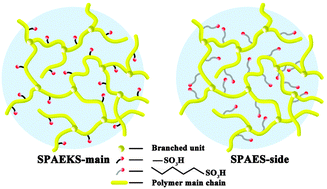Synthesis and properties of highly branched sulfonated poly(arylene ether)s with flexible alkylsulfonated side chains as proton exchange membranes†
Abstract
Comb-shaped sulfonated poly(arylene ether)s exhibit excellent properties when applied in proton exchange membranes (PEMs). However, few investigations have reported the use of comb-shaped sulfonated polymers with highly branched backbones as PEMs. In this work, a series of highly branched sulfonated poly(arylene ether)s with flexible alkylsulfonated side chains were successfully synthesized for the first time. The branched polymers were soluble in polar organic solvents and could be cast to form tough and smooth films. The membranes exhibited good overall properties as PEMs. With an increasing degree of branching (DB) value, properties such as oxidative stability, proton conductivity and swelling ratio of the membranes were significantly improved. The membrane with the highest DB value (8%) exhibits high proton conductivity (0.33 S cm−1 at 80 °C) and excellent oxidative stability (445 min) as well as acceptable mechanical properties (20.51 MPa), which indicate that this material is a good candidate PEM for evaluation in fuel cell applications.


 Please wait while we load your content...
Please wait while we load your content...